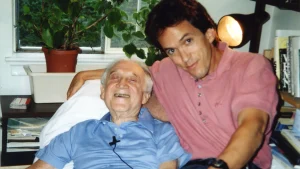Remembering SOPHIE: The Transformational Pioneer of Hyperpop
Feb 7, 2021
In the single “LEMONADE,” SOPHIE bent synthesized loops, rhythm, and melodies to create the illusion of bubbles popping. In “L.O.V.E.,” SOPHIE’s employment of droning white noise is the phonetic imitation of the pink-and-purple plastic bug on the single’s cover. In “VYZEE,” any sense of production through musical synthesis is gone, replaced by the sound of physical materials (e.g. balloons rubbing, bubbles popping, metal clanging, etc.) in motion.
SOPHIE told stories through vibrant and absurd musical textures, which were always equally, if not more, important than the spoken word. For SOPHIE, the text was not intended to be closely examined for deeper meaning.
Following SOPHIE’s passing, musician Vince Staples took to Twitter to reflect on his experience with SOPHIE’s carefree, effervescent nature in the studio.
“And don’t let the verse be deep or heartfelt cause she stopping the computer and walking outside until you get bacc on some gangsta shit,” Staples wrote.
Having been infatuated with music from a young age, pop producer SOPHIE began producing music, crafting singles, and collaborating with PC Music founder A.G. Cook in the early 2010s. Ranging from slow synthesized sonics to harsh and surreal hyperkinetic beats, SOPHIE’s music operates within modern pop to both pay homage to it and critique it, while simultaneously transcending the genre barriers altogether. To do so, SOPHIE superimposed the producer’s signature material noises in place of pop’s text repetition and the “‘millennial whoop.”’
SOPHIE’s ascension beyond genre was incredibly impactful on hyperpop, and the musician’s impact on the expansion of music collectively is perpetuated through collaborations with a wide variety of modern musicians. Before passing in January 2021, SOPHIE collaborated with artists such as Charli XCX, Lady Gaga, Madonna, Nicki Minaj, and Vince Staples. SOPHIE’s hyperpop influence is more apparent on some of these tracks than others, yet the influence is apparent to anyone who recognizes key elements of SOPHIE’s music.
Sophie was different you ain’t never seen somebody in the studio smoking a cigarette in a leather bubble jacket just making beats not saying one word.
— vince (@vincestaples) January 30, 2021
Hyperpop would not sound the way it does today without the groundbreaking innovations of SOPHIE and PC Music founder Cook. Although seemingly nonsensical upon first listen, the genre is anything but. The sound is ever-changing; its maximalist approach to pop music makes it fascinatingly avant-garde.
VICE journalist Eli Enis described hyperpop’s identity as “less rooted in musical genetics than it is a shared ethos of transcending genre altogether, while still operating within the context of pop.”
“I think all pop music should be about who can make the loudest, brightest thing,” SOPHIE said in a 2015 interview with Rolling Stone and Cook. “‘That, to me, is an interesting challenge, musically and artistically. And I think it’s a very valid challenge — just as valid as who can be the most raw emotionally.”
SOPHIE’s ability to warp and bend generated noises to sound like real materials is SOPHIE’s rejection of the pressure to employ obsolete, outdated sounds and instruments from music from the latter half of the twentieth century. To do so, SOPHIE favored the Elektron Monomachine, a music synthesizer and sequencer first produced in 2004. With the Monomachine, it became second nature for SOPHIE to render the sounds of balloons, bubbles, latex, and more.
In an archived interview with Elektron Music Magazine, SOPHIE spoke on the advantages brought about by the machine.
“I’m rather fixated on this idea of a monophonic, elastic, full frequency range morphing composition,” SOPHIE said. “I really like the Monomachine for two things. Sketches and sound design. […] It’s the machine I feel most fluent working on if I have an idea for a sound. I can experiment with it most quickly there.”
On Jan. 30, SOPHIE’s label, Transgressive, announced the musician’s passing in Athens, Greece on social media.
“True to her spirituality she had climbed up to watch the full moon and accidentally slipped and fell,” the post read. “She will always be here with us.”
— Transgressive (@transgressiveHQ) January 30, 2021
SOPHIE’s debut studio album, Oil of Every Pearl’s Un-Insides, was released in June of 2018. The album’s manipulation of sound simultaneously challenges the limitations of the gender binary, which is an inseparable element of SOPHIE’s music. SOPHIE’s approach to making music mirrors who SOPHIE was as an individual.
The album begins with an embrace of mutual vulnerability in “It’s Okay to Cry.” Accompanied by a self-produced music video, the single also marked the first instance in which SOPHIE’s face was used in any promotional material — the artist had existed mostly in the dark before that. Depicted topless in front of a backdrop of clouds, some listeners interpret this as SOPHIE’s announcement of being a transgender woman. SOPHIE preferred to not be referred to with the use of pronouns.
“For me, transness is taking control to bring your body more in line with your soul and spirit so the two aren’t fighting against each other and struggling to survive,” SOPHIE said in an interview with Paper Magazine in 2018.
The thematic and sonic elements of the album arguably place it as the largest opportunity provided to listeners to take a glimpse into the mind and soul of SOPHIE — imperfections and all. For both listeners and those who worked closely with SOPHIE, such a display of vulnerability was rare.
With SOPHIE’s extensive history of collaboration and production with various musicians, it is likely that even those who have never heard the name SOPHIE have heard music touched by the producer’s contribution to modern music. SOPHIE will be remembered for unabashedly challenging the limitations of genre and gender. As long as there is a musician intent on imagining and creating, SOPHIE’s musical precedents will continue to shape and sway the manipulation of sound.
Image courtesy of The FADER.















